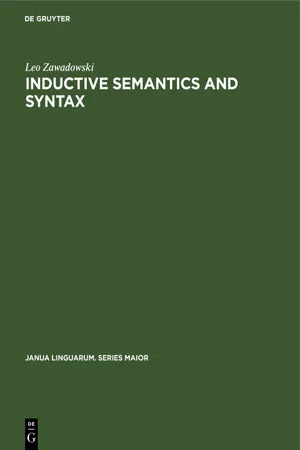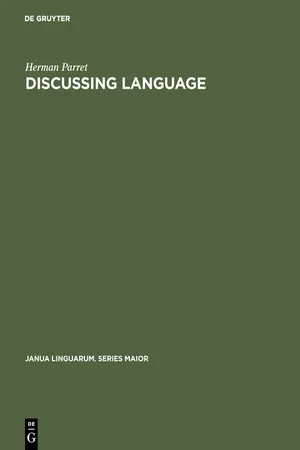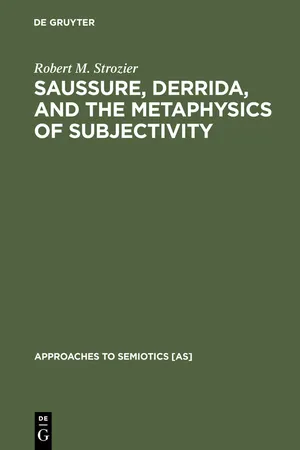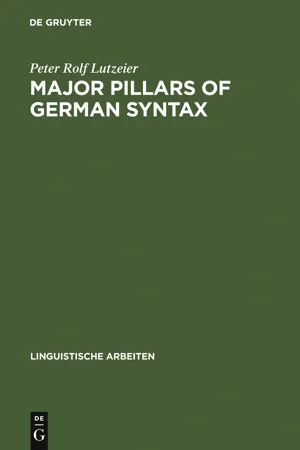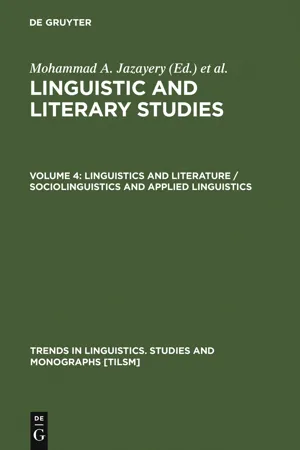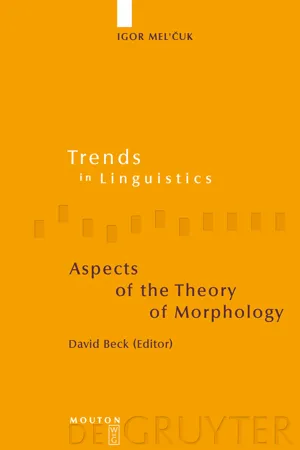Languages & Linguistics
Syntagmatic Relations
Syntagmatic relations refer to the way in which linguistic units, such as words or phrases, are combined to form meaningful sequences within a sentence or discourse. These relations involve the linear arrangement and sequential order of elements in a language, and they are essential for understanding the structure and meaning of linguistic expressions. Syntagmatic relations are a fundamental aspect of language and play a crucial role in communication and comprehension.
Written by Perlego with AI-assistance
Related key terms
1 of 5
10 Key excerpts on "Syntagmatic Relations"
- (Author)
- 2015(Publication Date)
- Cuvillier Verlag(Publisher)
Such linear combinations in discourse are called ‘syntagms’. “In the syntagm a term acquires its value only because it stands in opposition to everything that precedes or follows it” ([1916] 1960: 123). At the same time every element of a syntagm stands in a paradigmatic relation to any other element that could take its place in the same syntagm according to the rules of the language system. Saussure called such relations ‘associative’ because they were based on the association between a present element and absent ones that could fulfil the same function within the syntagm, i.e. replace the former. Syntagmatic and paradigmatic relations are associated with a horizontal and a vertical perspective towards language. They structure the language system and reveal aspects of meaning and lexical dependencies. Sinclair deals with the same issue of language interpretation. He states that on a rather abstract semantic level, meaning can be assigned to words or word-classes by being chosen among others, which is called ‘paradigmatic choice’. Additionally, words usually take part in the realisation of a larger item or unit, Dieses Werk ist copyrightgeschützt und darf in keiner Form vervielfältigt werden noch an Dritte weitergegeben werden. Es gilt nur für den persönlichen Gebrauch. 19 defined as ‘syntagmatic relation’ (cf. Sinclair 1998: 14). Sinclair/Mauranen (2006: 134) put this as follows: A text forms along the syntagmatic axis and consists of a string of items chosen from what is available on the paradigmatic axis. Traditional linguistic theory had put an emphasis on paradigmatic choice for quite a long time, which led to single words being associated with too much independent meaning while neglecting their environment. It focused on the segmentation and classification of decontextualised entities. Contextualism, on the other hand, relies its language description on contextualised entities and hence on the observation of Syntagmatic Relations, too.- Uwe Junghanns, Luka Szucsich, Uwe Junghanns, Luka Szucsich(Authors)
- 2011(Publication Date)
- De Gruyter Mouton(Publisher)
These relationships may be purely semantic (for example, agent, patient, beneficiary) or they may represent different levels of linguistic structure: syntagmatic (subject, direct or indirect object, predicate, complement) or paradigmatic (case, gender, person). The latter enter into larger classes of morphosyntactic relationships, known as grammatical categories ... (p. 107) 2 Tania Avgustinova While paradigmatic relations are functional contrasts and involve dif-ferentiation, Syntagmatic Relations are possibilities of combination of interacting items chosen within a framework of rules and conventions (both explicit and implicit), e.g., on the basis of a grammar system. They link together elementary constituent segments or minimal signifi-cant units which themselves belong to various paradigms. Mature lin-guistic theories develop nowadays powerful ontologies for linguistic objects and categories (like words, phrases, sentences) as well as rich inventories of relations among properties of these objects (e.g., agree-ment, subcategorisation, long-distance dependencies, etc.). Yet, no consistent account of grammatically relevant relations can be found. The key hypothesis put forward here is that systematic relations mo-tivate shared patterns of variation cross-linguistically as well as across constructions. To adequately encode the metagrammar of systematic relations, we need an ontological level of grammatical abstraction. This ontological level can be encoded as compatible multidimensional hier-archies of types of linguistic entities, with constraint inheritance from more general to more specific types. In short, the hierarchy allows for the expression of (possibly cross-cutting) generalisations and a specifi-cation of (in)compatibility between types. The generalisations are captured by factoring them out as constraints on super-types, as well as allowing types to have more than one super-type.- eBook - PDF
Inductive Semantics and Syntax
Foundations of Empirical Linguistics
- Leo Zawadowski(Author)
- 2019(Publication Date)
- De Gruyter Mouton(Publisher)
10 SYNTAGMATIC AND COMMUTATIONAL RELATIONS 1. CONJUNCTION AND DISJUNCTION 1.1. Structural linguistics introduced a.o. relations as an important part of data on which linguistic statements have to be based and in terms of which they have to be formulated. 'Distribution* came to be widely used as a decisive criterion for the establishment of linguistic facts, and had been used so for years, before it was shown that the term was used in a confused, and partly contradictory, way. 1 In fact, generally, there is much confusion in the use of relational phenomena in the description of languages: there are few definitions and still fewer proofs. Glossematics, in spite of its shortcomings, has this to commend itself: it tries to order its statements in some epis-temological order — from primary statements to those based on them, and so on — to define terms, and even to prove general statements (although the proofs are seldom satisfactory). Therefore in trying to define some fundamental terms we shall state our relation to glossematic views. 2 It is not correct to think that as glossematics has not produced an extensive school it is not worthwhile to study its opinions. The absence of an extensive school is of no importance in judging the validity of a doctrine. As for the doctrine, much of it is not valid, but it deserves to be refuted, because glossematics is epistemologically carefully built, and in this respect better than many other doctrines. We shall not commit the mistake of asking: what are the syntagmatic and the commutational ('paradigmatic') relations? Such a question implies that the thing in question exists and should be called by such and such a name. Instead, we have to inquire into the use of the existing terms on one hand, and into the relations really existing in the field in question on the other. 1.2. Glossematics assumes a priori that for every process there is a corresponding 1 P. - eBook - PDF
Understanding Language
A Study of Theories of Language in Linguistics and in Philosophy
- (Author)
- 2019(Publication Date)
- De Gruyter Mouton(Publisher)
At times linguists talk in ways that would lead to misunderstandings concerning syntax and seman-tics. For example, linguists and others in the cognitive sciences talk about semantic representation or semantic structures as if it made sense to talk of semantic analysis apart from some syn-tactic parsing. Possibly some have been misled by the slogan according to which grammar relates sound to meaning. This slogan suggests the picture of an independent realm of semantic structures and then a set of syntactic rules that relate these to the phonological component. Such a picture is totally misleading. Perhaps some have thought of the specification of primitives and the definitions which then relate these to all defined terms as some sort of independent structure. But the task of sorting out the primitives and providing definitions for the other terms CANNOT take place until one has determined what syntactic cat-egories the language has available. Definitions as well as the assignment of meanings to the primitives must take into account the syntactic category in which the items in question fall. It is incoherent to think of the rules of language as starting with lexi-cal decomposition and then somehow, via transformations, ar-riving at the sentences of the language. That kind of analysis would miss the syntactic categories, and thus could not contain formation rules. It could not explain what makes certain units into sentences, i.e. that which is true or false. This is the force of Quine's dictum that logic chases truth up the tree of gram-mar. Rules that explain how the complex is made up of parts are needed both for the syntax and the semantics. - eBook - PDF
Discussing Language
Dialogues with Wallace L. Chafe, Noam Chomsky, Algirdas J. Greimas, M. A. K. Halliday, Peter Hartmann, George Lakoff, Sydney M. Lamb, André Martinet, James McCawley, Sebastian K. Saumjan, Jacques Bouveresse
- Herman Parret(Author)
- 2017(Publication Date)
- De Gruyter Mouton(Publisher)
And I found that those existing in lexotactics are of the same kind as those in phonotactics, etc. I regard this finding as in harmony with the reality of the situation; that is, in the actual mental structures involved we will some day find the same kind of neural configurations. This similarity would not be found by a linguistc school which didn't get its structure abstracted from the raw data. If you are close to the raw data, then you will be struck by the differences, as in transformational gram-mar where one finds that phonological structure looks rather different from the struc-ture of other levels. 196 SYDNEY M. LAMB Are the relations between the different units on each level of a logical kind? Do you notice for instance the relations of equivalence, alternation, opposition, etc. ? - Each of these relations has its correlate in our relational network. And they are found at all levels of the linguistic structure. One of the most provocative elements of your theory is that language is a network of relationships and not of entities. That is a very radical conception... - Yes it is, and I have found that people have a great deal of difficulty in understanding this. Let me therefore try to explain this point by taking a typical example of a mor-pheme. We could think of a morpheme such as dog, and ask ourselves: what is this morpheme ? Let us not be satisfied with any answer that falls short of saying completely what it is. To characterize it we can give a complete list of its properties as a morpheme of the language. In the first place it has a phonological form which we can represent as d followed by o followed by g. In the second place it has a certain grammatical function which can be summarized as 'noun'. In the third place it has a certain meaning or several meanings. These meanings we will characterize by connecting dog to one or more concepts (and for the moment we leave aside the question of the nature of a concept). - Stefan R. Fink(Author)
- 2011(Publication Date)
- De Gruyter(Publisher)
In order to investi-gate the acceptability of an utterance we also have to consider 'expression rules' (Leech 1974:181) that link semantically well-formed prepositional concepts to syntactically well-formed sentences. 2.2.2 Isolating syntactic constituents Before we examine correlations between semantic elements, such as arguments and predicates, and their syntactic counterparts, it is necessary to reflect on criteria used for the delimitation of syntactic constituents (syntagmas). The distinction between syntagmatic and paradigmatic relations has been ex-tensively used in structural linguistics and defined thus: By virtue of its potentiality of occurrence in a certain context a linguistic unit enters into relations of two different kinds. It enters into pa rad igma tic relations with all the units which can also occur in the same con-text (whether they contrast or are in free variation with the unit in question); and it enters into syntagmatic re-lations with the other units of the same level with which it occurs and which constitute its context. (Lyons 1968:73) 1 Leech makes the quite useful distinction between 'predication 1 as the semantic correlate of a sentence and 'predicate' as the semantic correlate of the verb (1974:135). We follow this concept in our re-search. 28 The substitution test comprises the primary criterion, supplemented by the permutation test. Brinker (1972) distinguishes four theoretical possi-bilities for the status of a syntactic constituent: 1) permutable and substitutable 2) not permutable and not substitutable 3) permutable, but not substitutable 4) not permutable, but substitutable Brinker uses these criteria for German only; we would like to use them in a wider framework and will therefore test their applicability to English. The operations above must not result in any change of information content' in the sentence. 1) Permutable and substitutable: ( ' · ) The lady from New York arrived with the eight o'clock train.- Robert M. Strozier(Author)
- 2012(Publication Date)
- De Gruyter Mouton(Publisher)
Chapter 3 Method: Syntagmatic and Associative Structures of Langue When he comes to consider syntagmatic and assoc-iative relations in langue, Saussure has completed the first of the substantive sections of Part II of the Cours, on synchronic linguistics. Before this he has isolated within langage both langue and parole (in the Introduction) and distinguished between synchronic and diachronic linguistics (in Part I). Part II falls into a number of distinct parts, not all of which concern us here. Saussure isolates the sign as the unit of langue in the first four chapters. At least half of this section is introductory, and the first half is set up in terms of certain positivistic assumptions which are trans-formed in the later part of the analysis, in Chap-ter IV. The consideration of syntagmatic and associative relations in langue begins with Chapter V and continues into VI; following this Saussure uses his definition of the mechanism of langue, as he labels it, and how it functions in discourse, to redefine synchronic parole. Next are the impor-tant sections considering the structure of langue in terms of arbitrariness and relative motivation, and the final discussion of the relation of gram-matical form to Saussure's own conception of the form of langue, and the role which abstract enti-ties play in langue. Saussure's isolation of the sign results from his conception of how the form of langue is induced upon the previously undifferentiated matter pro-vided by the ranges of conceptuality and sound-imagery. This yields the unit in theory, yet it is a unit of no practical or immediate use. Within the two syntagmatic/associative sections, for 56 Chapter 3 example, Saussure substitutes the word, or parts of words, as nominal units. In a practical sense, he has no choice, for the abstractly isolated unit is not available to the analysis.- eBook - PDF
Major pillars of German syntax
an introduction to CRMS-theory
- Peter Rolf Lutzeier(Author)
- 2012(Publication Date)
- De Gruyter(Publisher)
177 seven-tuoeis. still, as we shall be able to gather from my examples, marking structure and suprasegmental structure can often be suppressed. 3,2,4 Syntactic-semantic relations for German At the moment, I think i can do justice to the requirements of the relational organization of German by means of six syntactic-semantic relations. The names of these relations are given in the most general, abstract terms and each one of them is meant to catch a typical aspect of how items in a holis-tic scene might be seen as being interrelated with each other. Plenty of Illu-strations should contribute towards a better understanding of my approach. 3,2.41 'Source'-Relation/'Goal'-Relation As far as the network of the items which are perceived by/conceived of and verbalized by the speaker/writer is concerned, I speak of a tendency to high-light in the particular scene a sort of directed path between two Items, one item being the source (of the event) and the other one being the goal (of the event). R 1, my first relation, involves the source of the event and is therefore called 'Source'-Relatlon. R 2, my second relation, involves the goal of the event and is therefore called 'Goal'-Relatlon The direction of the perceived/conceived interaction between two mentioned items is the de-cisive factor here: the abstract starting point of this Interaction qualifies for the source and the abstract end point of this interaction qualifies for the goal; cf, diagram 18 on the next page, I shall have to come back to this important issue of what is going to be decisive for the allocation of my relations in a short while. - Mohammad A. Jazayery, Edgar C. Polomé, Werner Winter, Mohammad A. Jazayery, Edgar C. Polomé, Werner Winter(Authors)
- 2011(Publication Date)
- De Gruyter Mouton(Publisher)
SYNTACTIC ARGUMENTS AND ROLE RELATIONSHIPS: ARE THERE SOME OF THE LATTER IN ANY OF THE FORMER? DELL HYMES 1. I associate Arch Hill with the richness of language as well as the rigor of linguistics because my first Linguistic Institute was spent partly in a seminar on literature and linguistics he helped conduct. That was twenty years ago, when the application of linguistic insight to the literary domain seemed frighteningly mechanistic to many scholars of literature, and suspiciously unscientific to many linguists. Now mediation between those two domains has resulted in a flourishing field of research. In this brief tribute I should like to suggest that mediation between linguistics and another domain may also yield something of value to both. The domain is that of social relationships. Much recent work in linguistics has recognized the necessity of taking into account charac-teristics of the context and participants in discourse (e.g., Finth 1935, Gunter 1966, Halliday 1970; Hymes 1964a: 38, 1964b: 3, 1970: 130; Jakobson 1957, 1960; Labov 1970, section 4; R. Lakoff 1969, mss. Nida 1945, Pike 1967: §1, 4, 2.13, Sapir 1933:151-8 ( = 1949:11-12), Tyler 1966, Wheeler 1967, Whiteley 1966.). Such work may be said to explore the ways in which sentences, as acts of speech, necessarily involve two complementary aspects of meaning, the 'referential' and the 'social'. In sociology the work of Harold Garfinkel, Erving Goffman, Harvey Sacks, Emanuel ScheglofF, and others has shown the necessity of taking into account characteristics of discourse. Such work may be said to explore the ways in which social relationships necessarily involve the management and on-going interpretation of discourse. These two areas of research have increasingly converged, but not quite joined. For the linguist, analysis of social relationships is typically in-formal, a matter of ad hoc contents (but cf. Fought 1972 on Goffman's notion of with).- eBook - PDF
- Igor Mel'cuk, David Beck(Authors)
- 2008(Publication Date)
- De Gruyter Mouton(Publisher)
520 Chapter 10. Linguistic signs and the semantic-formal relations between them words (= lexemes) – must be solved based on the descriptions of these signs on the plane of content and on that of expression. The descriptions themselves have to be developed first, and in quite an autonomous way. All possible combinations of the above four relations on the two planes yield 17 different types of semantic-formal relations possible between any two lin-guistic signs. Thus, let there be two linguistic signs A and B ; here are logically possible cases of semantic-formal relations between them, organized in four groups (I-IV): I. The signifieds of A and B are identical (i.e., ( A ) and ( B ) are equal): 1) ( A ) = ( B ) , /A/ = /B/ 2) ( A ) = ( B ) , /A/ /B/ 3) ( A ) = ( B ) , /A/ /B/ ≠ 4) ( A ) = ( B ) , /A/ /B/ = II. The signified of A is a part of the signified of B (i.e., ( A ) is included in ( B ) ): 5) ( A ) ( B ) , /A/ = /B/ 6) ( A ) ( B ) , /A/ /B/ 7) ( A ) ( B ) , /A/ /B/ NB : There is no correspondence to Case 7 in Groups I, II, and IV, because the relations considered in these groups – equality, non-empty intersection and empty intersection – are symmetrical and need not to be examined in both directions. 8) ( A ) ( B ) , /A/ /B/ ≠ 9) ( A ) ( B ) , /A/ /B/ = III. The signifieds of A and B overlap (i.e., they have one part in common, with-out being identical or included one in the other): 10) ( A ) ( B ) ≠ , /A/ = /B/ 11) ( A ) ( B ) ≠ , /A/ /B/ 12) ( A ) ( B ) ≠ , /A/ /B/ ≠ 13) ( A ) ( B ) ≠ , /A/ /B/ = IV. The signifieds of A and B have no part in common (i.e., they are disjoint): 14) ( A ) ( B ) = , /A/ = /B/ 15) ( A ) ( B ) = , /A/ /B/ 16) ( A ) ( B ) = , /A/ /B/ ≠ 17) ( A ) ( B ) = , /A/ /B/ = 7 3. Greater/lesser complexity in relations between linguistic signs 521 3.
Index pages curate the most relevant extracts from our library of academic textbooks. They’ve been created using an in-house natural language model (NLM), each adding context and meaning to key research topics.


